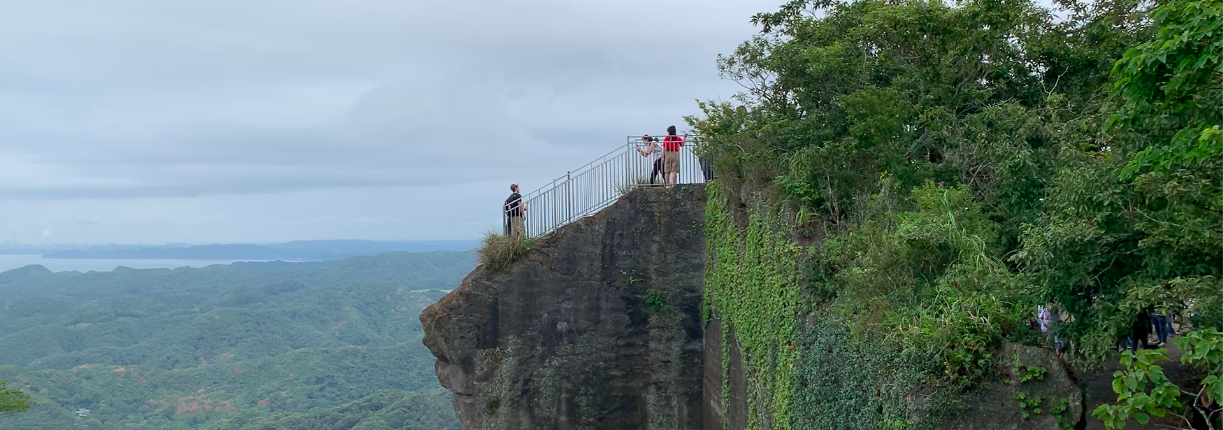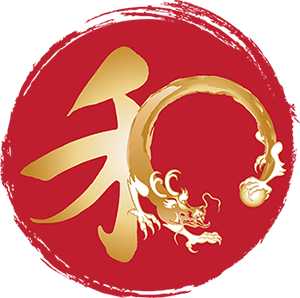READING TIME: 5 MINUTES.
A little bit of history
Yesterday we went on a trip to Mt. Nokogiri – the sacred mountain of the Kantō region to see the Nihonji Temple on its top. Founded in 725AD the temple is the oldest in this part of Japan. It was burnt or destroyed many times through its long history but each time rebuilt again. Centuries ago the temple was visited by some remarkable historical figures like the legendary Kūkai, the founder of the esoteric Shingon sect (and the person behind the creation of the temple city at the sacred Mt. Koya), and Ruben – the founder the famous Todaiji temple in Nara. Reading about the temple’s rich history was like reading about the history of Buddhism in Japan. Founded as a Yoga-cara school temple (an ancient form of Buddhism) it later changed its affiliation to the native Tendai school and is presently a Zen temple.
Getting there
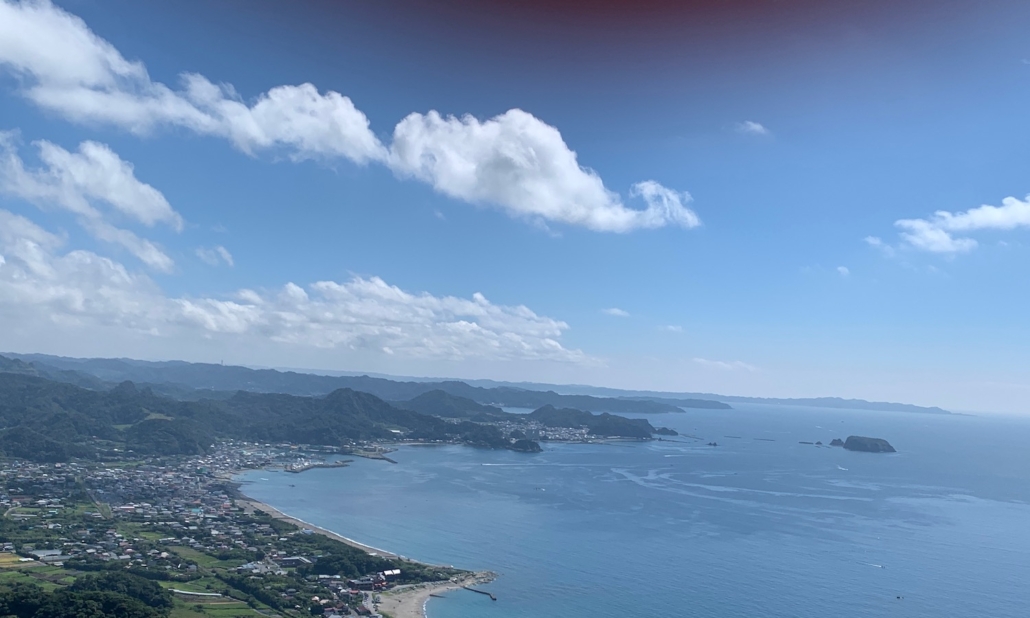
The Pacific coast of Chiba peninsula
Mt. Nokogiri is at the southern tip of the Chiba peninsula, about an hour drive north of Tokyo. There are several ways to get to the top of the mountain where the temple complex is: there is a toll road going there, you can take a gondola lift or you can climb on foot. There is free parking available for all three options. We chose the gondola lift, a brief 4 min ride that took us to a side of the mountain with a spectacular panorama view to the Pacific coast of the peninsula and its inland mountains and the Tokyo Bay to the south. However next time I go I want to climb up on foot and experience the mountain as it was meant to be experienced when Nihonji was founded.
The temple
Needless to say, I was very excited about this trip as this was my first visit there. Apart from the huge Buddha carved into the rock and the stone statue of Kannon, there were several other things I couldn’t wait to see. Furthermore, from the photos I had seen the place seemed to have an interesting vibe: a bit mysterious that somehow reminded me of the ancient temples in Egypt. And, I love things that are mysterious!
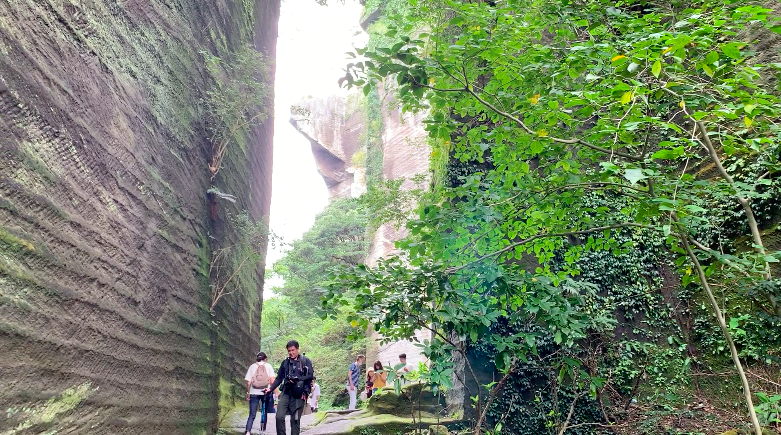
The path to the statue of Kannon goes through a deep gorge with Jigoku Nozoki cliff in the background
I must say Nihonji temple exceeded all my expectations – it is called a temple but it isn’t the usual Buddhist temple with temple buildings and such. It is as if the whole top of the mountain is the temple! The actual temple buildings, except two pavilions, are not open to the public but there is still so much to see.
The statue of Kannon and Jigoku Nozoki
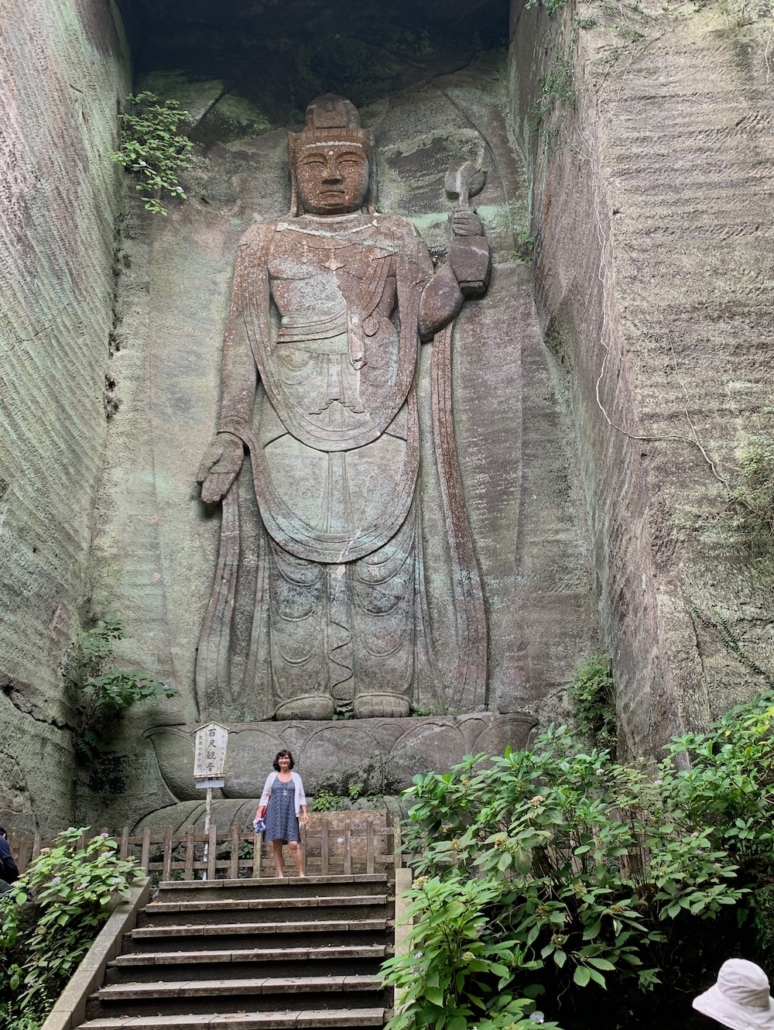
The author at the foot of the statue of Kannon
The first thing we saw was the 30 meters bas relief sculpture of Kannon, the Goddess of Mercy carved into a huge cliff. The path to it goes through deep gorges with perfectly vertical walls – the area was used as a quarry several centuries ago and you can still see the marks of the carving tools on the high stone walls. Very little sunlight gets to the bottom of the gorges and the relative darkness creates the perfect environment for moss, ferns, and vines to grow. They cover the ground, the rock faces, and the statue of Kannon itself giving them a mysterious, timeless vibe. Dedicated to those who lost their lives in the War, the Kannon statue is not old – it was completed in 1966, however it looks as if it has occupied its quiet niche in the stone wall for eons.
Standing in front of Kannon’s statue if you look towards the sky you see an overhanging piece of rock stick out, the famous Jigoku Nozoki (Peep into Hell.) If you like the thrill you can go to the edge of the cliff for a breathtaking 360 degrees view of the area.
The 1500 arhats
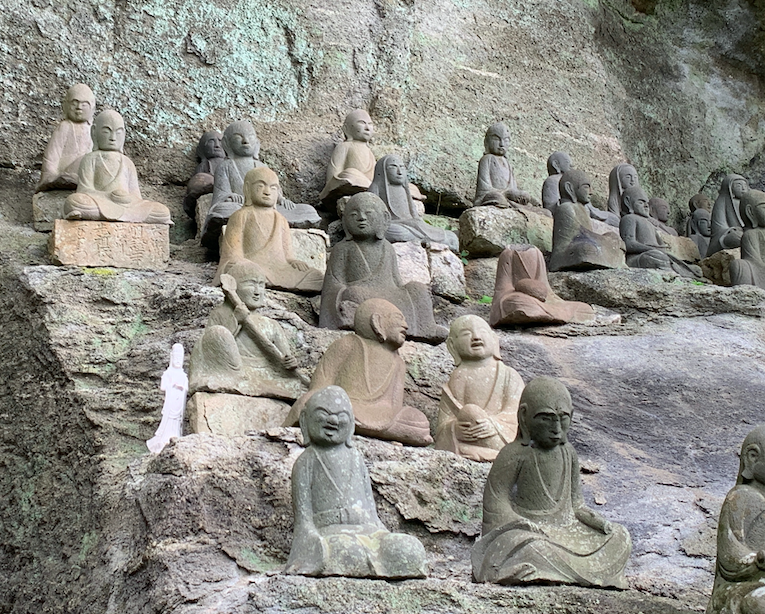
Arhat statues – their faces are so expressive and they are all different
The path to the top of the mountain and the paths between the various locations of the complex used to be lined with the statues of 1,500 arhats. Differently from jizo (bodhisattvas who are our guides in the human experience), arhats are beings who have achieved spiritual enlightenment or nirvana. During the rather tumulous history of the temple, some of those statues were either destroyed or their heads were cut off. Fortunately, many remained intact and can be seen displayed by the paths or at their original locations. I loved seeing the arhat statues because of their expressive faces – each had its own character. Some looked lost in meditation, some were serious and others had a dream-like expression. And then there were those who seemed engaged in a lively conversation with their neighbors. The statues felt alive and like each had a story to tell I could spend the day listening to.
The Big Buddha
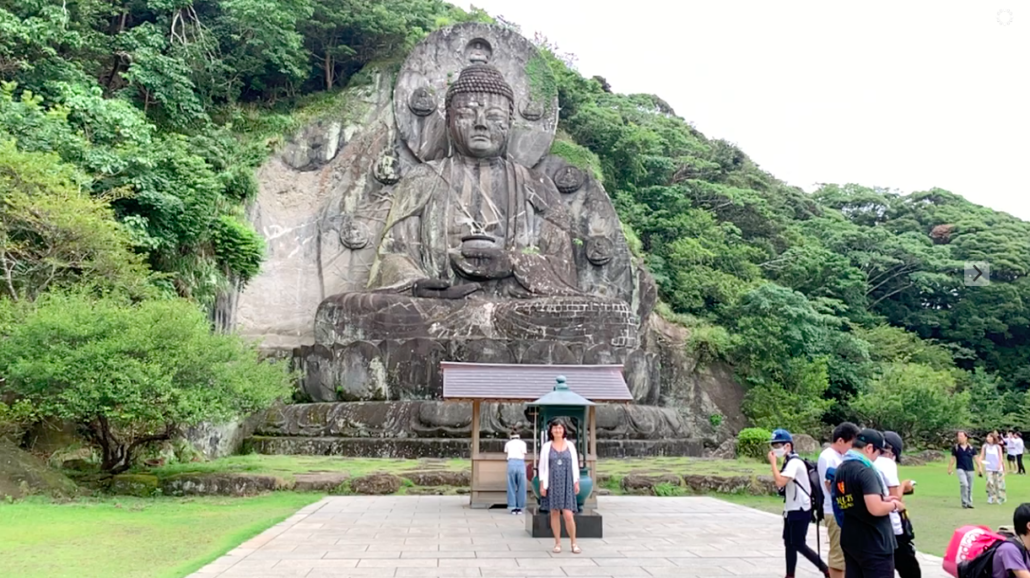
The Big Buddha statue of Nihonji – I couldn’t resist taking a photo with it
There are several Big Buddha statues in Japan (or Daibutsu in Japanese) – the Daibutsu in Kamakura and the one in the Todaiji temple in Nara are among the most famous. The biggest Daibutsu however is the one in Nihonji. Towering at an impressive height of 31 meters (almost 100 feet) one would expect it to be intimidating but it wasn’t. Surrounded by the green forest of the hill it was carved from, its presence was solid, serene, and strangely comforting.
Make a wish
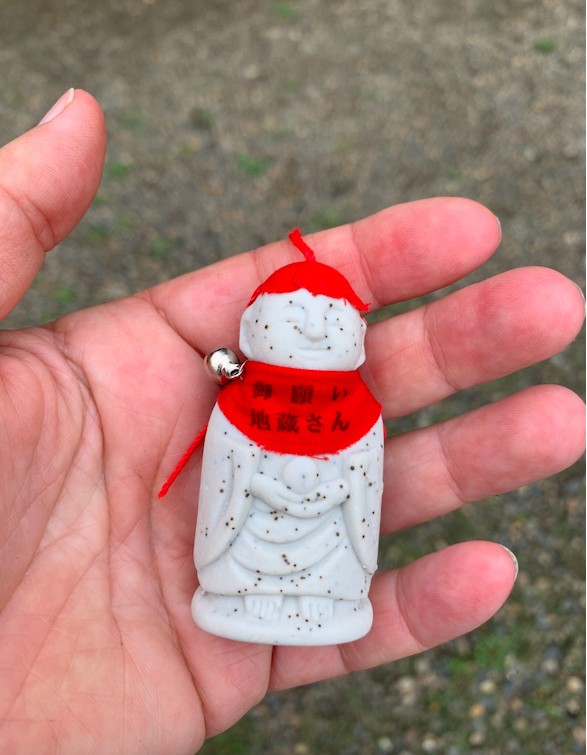
The little Jizo to wish on
I loved the open space in front of the Daibutsu – there were benches where you could sit and rest (the way there is downhill but quite strenuous) and take in the beautiful energy of the place. On the left of the Buddha statue, there was a smaller statue of the wish-granting Jizo (bodhisattva) of Mt. Nokogiri.
In the small shop selling amulets and fortune slips, you can buy a tiny version of it and write your name on its back. Then holding it in your hands you pray to the Nokogiri Jizo to make your wish true. I didn’t get a fortune slip but I did make a wish – my jizo is together with what looked like thousand other tiny statues, each one of them delivering a wish to the deity there. You can see the big Jizo statue and the mountain of smaller ones behind it in the video I am making. I will include a link here shortly.
Beautiful Mt. Nokogiri
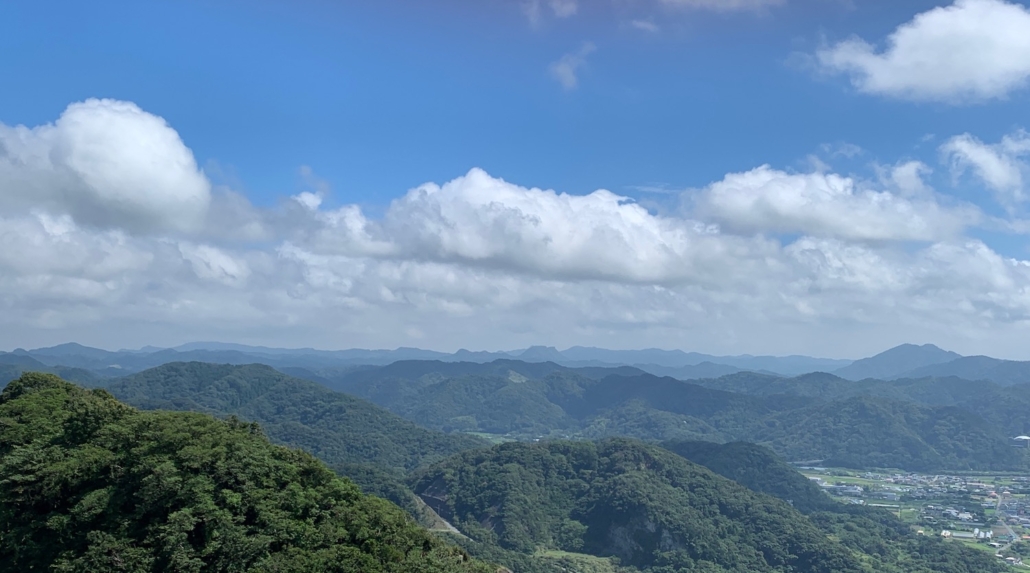 There is much more to see at Nihonji temple and Mt. Nokogiri – it will make for a very long travelogue if I write about it all. I also want to leave some things unsaid so you can make your discoveries if you decide to visit one day. There is one thing that I must do though and that is to give a big shout out to Mother Nature: the natural beauty of the place, lovingly maintained by its human caregivers is simply stunning. Being close to the ocean, the mountain has a climate that is milder and more humid than what we have inland. Its forests are dense and jungle-like, with palm trees that give it a very tropical vibe. There are little streams that run through the forest and their sound was sweet and cooling on the hot day we were there. So, prepare to be awed by the views you will see and to be enchanted by the lush green forest you will be walking through – both are an important contributor to the unique magic of this place.
There is much more to see at Nihonji temple and Mt. Nokogiri – it will make for a very long travelogue if I write about it all. I also want to leave some things unsaid so you can make your discoveries if you decide to visit one day. There is one thing that I must do though and that is to give a big shout out to Mother Nature: the natural beauty of the place, lovingly maintained by its human caregivers is simply stunning. Being close to the ocean, the mountain has a climate that is milder and more humid than what we have inland. Its forests are dense and jungle-like, with palm trees that give it a very tropical vibe. There are little streams that run through the forest and their sound was sweet and cooling on the hot day we were there. So, prepare to be awed by the views you will see and to be enchanted by the lush green forest you will be walking through – both are an important contributor to the unique magic of this place.
As an epilogue
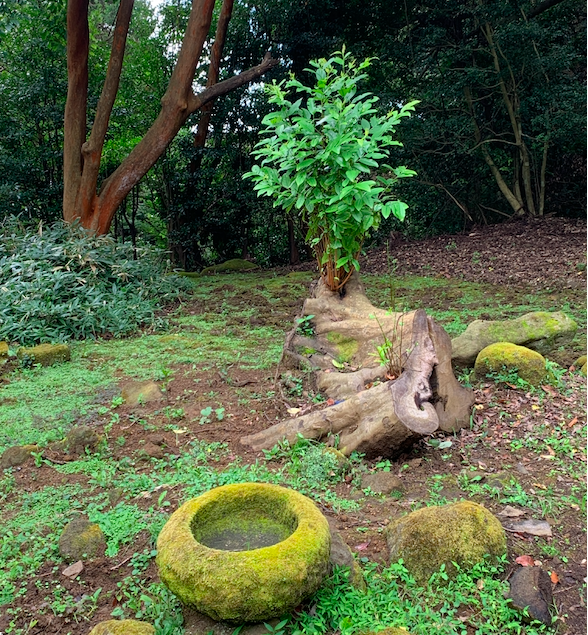
On the way out we saw a young tree with strong new branches growing out of a dead old stump. I thought that was a beautiful symbol of the history of Nihonji and the holy mountain it was built on – through the 1,300 years of its existence the temple has been destroyed many times only to spring back to life as something new again. It is old but its energy is not – just like that young tree it is beautiful and full of life.
Below is a video I took while visiting Nihonji temple. If you enjoyed it please subscribe to my YouTube channel for more videos about Japan, its beautiful nature and ancient spiritual traditions.
* The Spirit of Japan Tours organizes private and group tours to temples and sites where you can experience the richness of Japan’s spirituality and traditions. Please, message us for more information about our future tours.

